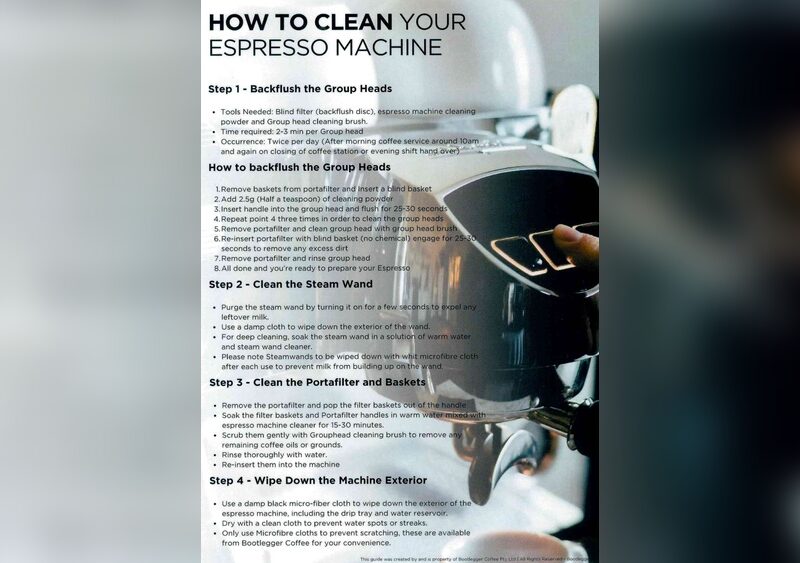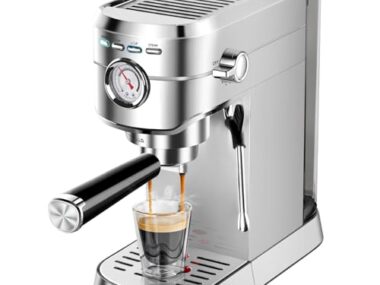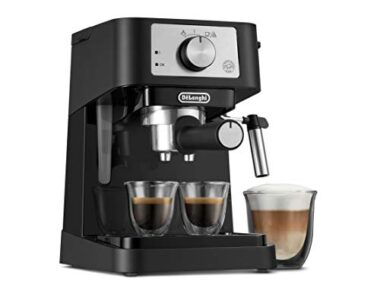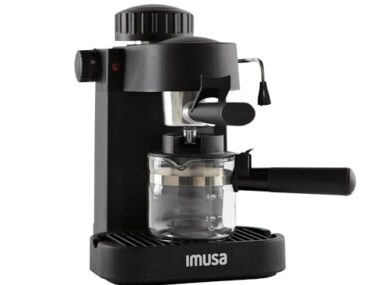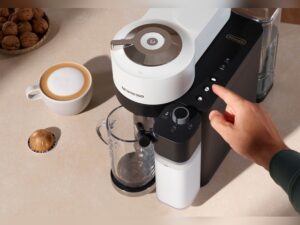If you love enjoying a fresh cup of espresso at home, keeping your machine clean is key. Over time, coffee oils and residue can build up, affecting the taste and performance of your espresso maker.
But don’t worry—cleaning your espresso machine doesn’t have to be complicated. In this guide, you’ll discover simple, step-by-step instructions to keep your machine in top shape. Follow these easy tips, and every cup you make will taste just as rich and smooth as the first.
Ready to master the art of espresso machine cleaning? Let’s get started!

Credit: coffeebi.com
Tools And Materials Needed
Cleaning an espresso machine requires a few simple tools and materials. Having the right items makes the process easy and effective. Each tool plays a specific role in keeping your machine clean and working well.
Prepare all tools before starting. This saves time and avoids interruptions. Use only recommended cleaning products to protect your machine.
Cleaning Brushes
Small brushes help remove coffee grounds from tight spaces. Choose brushes with soft bristles to avoid damage. They clean the group head, portafilter, and steam wand well.
Microfiber Cloths
Soft cloths wipe surfaces without scratching. Use them to dry and polish your machine. Microfiber cloths absorb water and coffee stains easily.
Descaling Solution
Descaling removes mineral buildup inside the machine. Use a solution made for espresso machines. Follow package instructions for safe use.
Cleaning Tablets Or Powder
Cleaning tablets or powder dissolve coffee oils and residue. They clean the group head and portafilter. Use as directed for best results.
Water And Containers
Fresh water is necessary for rinsing the machine. Use clean containers to catch water and cleaning solutions. This keeps the workspace tidy and safe.
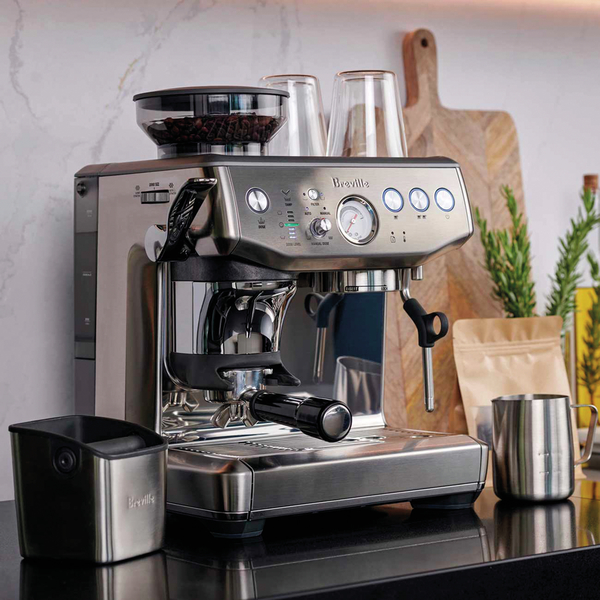
Credit: www.breville.com
Preparing The Machine
Preparing your espresso machine is the first step to a thorough cleaning. This stage ensures your safety and makes cleaning easier. It also helps protect your machine from damage. Follow these simple steps before you start cleaning.
Turning Off And Unplugging
Always turn off your espresso machine before cleaning. This stops electricity from running through the device. Unplug the machine from the power outlet next. This prevents any accidental shocks or short circuits. Wait a few minutes for the machine to cool down. Cleaning a hot machine can cause burns or damage.
Removing Parts
Take out all removable parts from the machine. These often include the portafilter, drip tray, and water reservoir. Check your user manual for specific parts to remove. Removing parts allows for a deeper clean. It also stops water from entering the machine’s electrical parts. Place the parts on a clean surface before washing.
Cleaning The Portafilter And Basket
Cleaning the portafilter and basket is a key step in maintaining your espresso machine. These parts hold the coffee grounds and are exposed to oils and residue after each use. Dirt buildup affects the flavor of your espresso and the machine’s performance. Regular cleaning keeps your coffee tasting fresh and your machine working well.
Soaking In Warm Water
First, remove the portafilter and basket from the machine. Fill a container with warm water. Soak the parts in the water for about 15 to 30 minutes. This loosens coffee oils and stuck grounds. Use plain warm water or add a small amount of mild detergent. Avoid harsh chemicals that can damage the parts.
Scrubbing And Rinsing
After soaking, scrub the portafilter and basket gently. Use a soft brush or sponge to clean all surfaces. Pay close attention to the basket holes where coffee oils collect. Rinse thoroughly under running water to remove soap and debris. Dry the parts completely before putting them back in the machine.
Descaling The Machine
Descaling an espresso machine removes mineral buildup inside the machine. This buildup can affect the taste of your coffee and the machine’s performance. Regular descaling helps keep your espresso machine clean and working well.
Choosing A Descaling Solution
Select a descaling solution made for espresso machines. You can find liquid or powder forms. Some solutions are natural, like vinegar or citric acid. Check your machine’s manual before choosing. Avoid harsh chemicals that can damage the machine.
Use the right amount of solution. Too much can leave residue. Too little may not clean well. Follow the instructions on the product label carefully.
Running The Descale Cycle
Empty the water tank and fill it with the descaling solution. Turn on the machine and start the descale cycle if it has one. If not, run the solution through the machine as if making coffee. Let the solution sit inside for 15 to 30 minutes.
After the solution has worked, rinse the tank and fill it with clean water. Run the machine several times with fresh water to remove any leftover solution. This step prevents bad taste in your coffee.
Cleaning The Group Head
The group head is the part of your espresso machine where hot water meets coffee grounds. It can get dirty with old coffee oils and particles. Cleaning it keeps your coffee tasting fresh and your machine working well. Regular cleaning stops clogs and helps your machine last longer.
Using A Brush
Start by turning off the machine and letting it cool. Use a small brush made for espresso machines. Brush around the group head’s edges and inside the filter basket. This removes coffee grounds stuck in small spaces. Brush gently but thoroughly to clear all debris. Clean the brush after use to keep it ready.
Backflushing
Backflushing cleans the inside of the group head. Insert a blind filter into the portafilter. Add a small amount of espresso machine cleaner. Lock the portafilter into the group head. Run the machine for about 10 seconds, then stop. Repeat this process 4-5 times. Rinse by running clean water through the group head. Backflushing removes oils and buildup deep inside.
Cleaning The Steam Wand
The steam wand is a key part of your espresso machine. It helps create frothy milk for cappuccinos and lattes. Cleaning it regularly keeps the taste fresh and prevents clogs. Follow these simple steps to clean your steam wand properly.
Wiping And Purging
After steaming milk, wipe the steam wand with a damp cloth. This removes milk droplets on the outside. Next, turn on the steam for a few seconds. Purging clears milk inside the wand. It stops buildup and keeps the steam flow strong.
Removing Milk Residue
Milk can dry inside the wand and block it. Use a small pin or needle to clean the tip gently. Soak the wand in warm water for 10 minutes to soften residue. Wipe it clean with a cloth after soaking. Regular cleaning stops milk from hardening inside.
Cleaning The Drip Tray And Water Reservoir
Cleaning the drip tray and water reservoir is key to keeping your espresso machine in top shape. These parts collect water, coffee grounds, and dirt during use. Regular cleaning stops bad smells and mold from growing. It also helps your machine work better and last longer.
Follow these simple steps to clean these parts properly. This keeps your coffee fresh and tasty every time you brew.
Emptying And Washing
First, remove the drip tray from the machine. Pour out any water or coffee inside. Use warm water and mild soap to wash the tray. A soft cloth or sponge works best to avoid scratches. Rinse the tray well to remove soap. Next, take out the water reservoir carefully. Empty all the water. Wash it with warm soapy water. Use a soft brush to clean hard-to-reach areas. Rinse the reservoir completely to avoid soap taste.
Drying Properly
After washing, dry both parts well. Use a clean towel to wipe them inside and out. Let them air dry fully before putting them back. This prevents mold and bacteria growth. Never put wet parts back into the machine. Dry parts keep your espresso machine clean and safe to use.

Credit: www.cafetto.com
Reassembling The Machine
Reassembling the espresso machine is the final step after cleaning. This process restores your machine to working condition. It ensures all parts fit correctly for the best coffee taste. Take your time to avoid mistakes. Follow each step carefully.
Cleaning Parts Before Reassembly
Make sure every part is dry and clean. Use a soft cloth to wipe off any water or debris. Check for coffee grounds stuck in small areas. Clean parts separately to prevent mold growth. Drying well helps avoid damage and rust.
Placing The Portafilter And Basket
Insert the filter basket back into the portafilter. Fit them tightly to avoid leaks. Lock the portafilter into the group head. Turn it to the right until you feel resistance. This step is important for good pressure.
Reattaching The Water Reservoir
Fill the water reservoir with fresh water. Place it back in its slot. Make sure it fits firmly without gaps. A loose reservoir can cause water flow problems. Check the seals and hoses for proper connection.
Securing The Drip Tray And Other Accessories
Slide the drip tray into its position under the group head. Lock or snap it if your machine has clips. Attach any other removable accessories like the steam wand tip. Ensure everything sits well and feels stable. Loose parts may cause spills or damage.
Maintenance Tips For Longevity
Keeping your espresso machine in good shape helps it last longer. Regular care stops damage and keeps coffee tasting fresh. Small habits make a big difference over time. Follow these simple tips to protect your machine and enjoy great coffee every day.
Regular Cleaning Schedule
Clean the machine after each use. Remove coffee grounds and rinse parts with warm water. Deep clean once a week using a special espresso cleaner. This removes oils and buildup inside the machine. Don’t forget to clean the steam wand and drip tray. A clean machine works better and lasts longer.
Using Filtered Water
Use filtered water to make your coffee. It reduces mineral deposits inside the machine. Hard water causes scale buildup that can damage parts. Filtered water keeps the internal system clean. This means fewer repairs and a smoother taste. Always refill your machine with fresh, filtered water.
Frequently Asked Questions
How Often Should I Clean My Espresso Machine?
Clean your espresso machine after every use for best taste. Deep clean it weekly to remove oils and buildup. Regular maintenance ensures better coffee flavor and longer machine life.
What Is The Best Way To Descale An Espresso Machine?
Use a commercial descaling solution or vinegar mixed with water. Run the solution through the machine, then flush with clean water. Descaling removes mineral buildup and improves machine performance.
Can I Use Regular Soap To Clean Espresso Parts?
Avoid regular soap as it may leave residues affecting coffee taste. Use mild detergent or manufacturer-recommended cleaners for removable parts. Proper cleaning keeps your espresso fresh and flavorful.
How Do I Clean The Portafilter And Basket Effectively?
Soak the portafilter and basket in warm, soapy water. Use a brush to remove coffee oils and grounds. Rinse thoroughly to ensure no residue remains for the best extraction.
Conclusion
Keeping your espresso machine clean helps it work well and last longer. Regular cleaning removes old coffee oils and buildup. This makes every cup taste fresh and rich. Follow each step carefully for the best results. Cleaning does not take much time but makes a big difference.
Enjoy great espresso every day with a clean machine. Simple care keeps your coffee experience strong and enjoyable. Don’t forget to clean often for the best flavor. Easy, small actions lead to great coffee moments.
